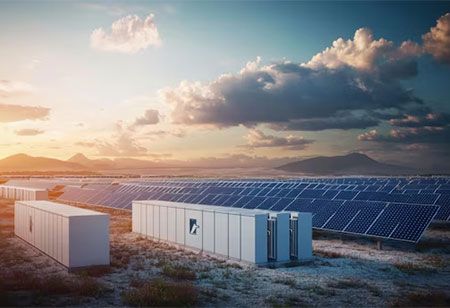
If you're considering switching to renewable energy, understanding your solar power storage options can be challenging. Decisions need to be made on the specific system that best suits your energy consumption patterns and budget.
One solution to navigate through the complexities of solar storage is by leveraging guidance from reliable sources. For your benefit, Evergreens solar guide provides in-depth knowledge and comprehensive information about harnessing solar energy.
This post will give you an overview as well, discussing various types of solar power storage available and their corresponding benefits. From simple batteries to sophisticated home energy management systems, we'll help you make an informed choice.
Understanding solar power storage begins by knowing the types available. This fundamental knowledge empowers you to make decisions based on your specific needs.
When it comes to solar power storage, there are several options available to you. But how do you know which one is right for you?
You need to consider factors such as their cost-effectiveness, dependability, and capacity. This will help you make an informed decision about your power storage solution.
All these battery options present unique benefits depending on your specific needs. Understanding each option's strengths and weaknesses is key in making an informed decision.
Thermal storage is a lesser-known but equally significant solar power storage option. It functions by harnessing heat from the sun during peak hours.
This stored thermal energy can be utilized to heat your home or water, often reducing the need to rely on other, more costly forms of energy.
Moreover, thermal storage provides you with the option to store excess solar energy without requiring heavy batteries or complicated installations, making it an environmentally-friendly choice.
You can learn more about these innovative techniques and their potential to revolutionize energy consumption from this HuffPost article.
When it comes to solar power, mechanical storage options present a diverse field. These rely on physical, often kinetic, energy to store and release power.
Solar power is converted into mechanical energy, profoundly reducing the reliance on fossil fuels. As a result, it marks an eco-friendly path to renewable energy.
Selecting the right mechanical storage rests upon your needs and preferences. Performance comparisons between different types will provide further clarity in your decision-making.
The potential of mechanical solar storage is substantial. Wider use could lead to dramatic reductions in global carbon emissions. Your commitment can create a significant impact.
Understanding the options for solar energy storage is important whether you're a homeowner or a business owner.
Exploring solar power storage involves understanding your options, including battery storage systems, thermal storage, and pumped hydro storage.
|
Storage Type |
Ease of Installation |
Cost Effectiveness |
|
Battery Storage Systems |
Moderate |
High |
|
Thermal Storage |
Difficult |
Moderate |
|
Pumped Hydro Storage |
Complex |
Varies by location and installation size |
|
Source: Energy.gov (for reference only) |
||
A battery storage system is a common option, easily integrated with your solar power system and providing excellent cost-effectiveness.
Thermal storage captures excess heat from the sun for later use, but it's less convenient than other options due to complexity in installation.
Pumped hydro storage's cost-effectiveness and easiness in installation can vary greatly depending upon location and size of installation.
Understanding solar power storage starts with grasping the key components. They include solar panels, an inverter, a meter, and obviously, a storage unit.
Solar panels capture sunlight to produce electricity. Their efficiency determines how much energy can be generated throughout the day.
The inverter transforms the direct current (DC) produced by solar panels into alternating current (AC), which is what household appliances use.
A meter keeps track of the power your solar system produces. Any excess power is sent back into the grid, offsetting your energy costs.
Storage units store any surplus electricity for future use. They're essential for uninterrupted power supply during night, cloudy days, or power outages.
When considering solar power storage, selecting the right kit is crucial. A suitable kit can maximize energy efficiency and cut down your utility bills.
Let's delve into various off-grid solar options that empower you with energy independence.
Solar energy storage types include lithium-ion batteries, lead-acid batteries, and flow batteries. They're used in conjunction with solar panels to store excess energy.
The solar battery in an off-grid system stores excess solar energy produced during the day. This reserved power can be used at night or during power outages.
No, there are differences related to lifespan, capacity, efficiency, and cost. Therefore, it's vital to assess your needs before choosing your solar battery.
Lithium-ion batteries generally have a longer life span, better efficiency, and higher energy density than lead-acid options, though they tend to be pricier.
No, not every battery is suitable for solar storage. The chosen battery should have capabilities compatible with your precise solar-panel setup and power needs.
With a profound understanding of solar power storage options, you're better equipped to maximize your energy efficiency. From exploring battery and thermal storage to dissecting mechanical options, your journey towards renewable energy is clear. Whether residential or commercial, your sustainable, off-grid lifestyle awaits.
We use cookies to ensure you get the best experience on our website. Read more...
Copyright © 2025 HomesIndiaMagazine. All Rights Reserved.